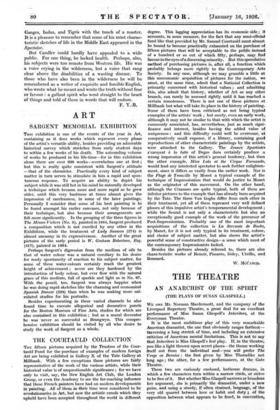ART
SARGENT MEMORIAL EXHIBITION
Tars exhibition is one of the events of the year in Art, containing as it does works .which represent every phase of the artist's versatile ability, besides providing an admirable historical survey which stretches from early student days to within a few weeks of his death. The astounding volume Of works he produeed his life-time—for in this exhibition alone there are over 600 works—overwhelms one at first ; but this is really quite consistent with. Sargent's attitude —that of the chronicler. Practically every kind of subject matter in turn serves to stimulate in him a rapid and spon- taneous response. To acquire an ability to depict his subject while it was still hot in his mind he naturally developed a technique which became more and more rapid as he grew older, until this very' hastiness at times almost gives the impression of carelessness; in some of the later paintings. Personally I -consider that some of his best painting is to be found amongst' his earlier canvases, not only because of their technique, but also because their arrangements are felt more significantly. In the grouping of the three figures in The Misses Vickers (No. 6), painted in 1884, Sargent produced a composition which is not excelled by any other in the Exhibition, while the treatment of Lady Sassoon (274) is idmost uncanny in its expressiveness. Another of the great pictures of the early period is W. Graham Robertson, Esq.
(417), painted in 1894. .
- Perhaps Sargent's digression from the medium of oils to that of water colour was a natural corollary to his desire for ready spontaneity of reaction to his subject matter, for some of these water-colours certainly reach the greatest height of achieiement ; never are they hardened by the introduction of body colour, but ever flow with the natural grace of this medium, full of sparkle and light as in No. 437. With the pencil, too, Sargent was always happier when be was doing rapid sketches like the charming and- economical Spanish Dancer (224) than when he was making' more cal- ciliated studies for his portraits.
Besides experimenting in these varied channels -he also found time to execute allegorical and decorative panels for the Boston Museum of Fine Arts, studies for which are also contained in this exhibition ; but as a mural decorator he . was 'never so successful as Brangwyn. This compre- hensive exhibition should be visited by all who desire to study the work of -Sargent as a whole.














































 Previous page
Previous page